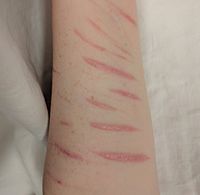
Photo from wikipedia
Elastomers with high dielectric permittivity that self‐heal after electric breakdown and mechanical damage are important in the emerging field of artificial muscles. Here, a one‐step process toward self‐healable, silicone‐based elastomers… Click to show full abstract
Elastomers with high dielectric permittivity that self‐heal after electric breakdown and mechanical damage are important in the emerging field of artificial muscles. Here, a one‐step process toward self‐healable, silicone‐based elastomers with large and tunable permittivity is reported. Anionic ring‐opening polymerization of cyanopropyl‐substituted cyclic siloxanes yields elastomers with polar side chains. The equilibrated product is composed of networks, linear chains, and cyclic compounds. The ratio between the components varies with temperature and allows realizing materials with largely different properties. The silanolate end groups remain active, which is the key to self‐healing. Elastomeric behavior is observed at room temperature, while viscous flow dominates at higher temperatures (typically 80 °C). The elasticity is essential for reversible actuation and the thermoreversible softening allows for self‐healing and recycling. The dielectric permittivity can be increased to a maximum value of 18.1 by varying the polar group content. Single‐layer actuators show 3.8% lateral actuation at 5.2 V µm–1 and self‐repair after a breakdown, while damaged ones can be recycled integrally. Stack actuators reach an actuation strain of 5.4 ± 0.2% at electric fields as low as 3.2 V µm–1 and are therefore promising for applications as artificial muscles in soft robotics.
Journal Title: Advanced Science
Year Published: 2022
Link to full text (if available)
Share on Social Media: Sign Up to like & get
recommendations!